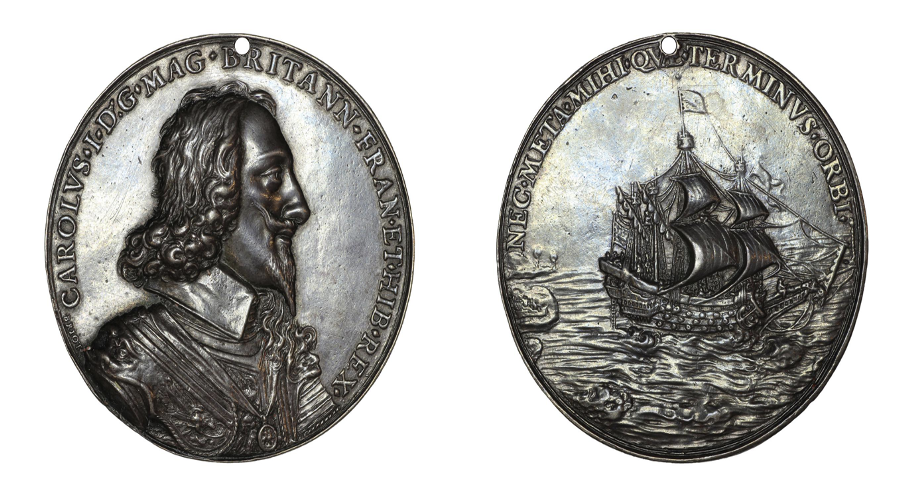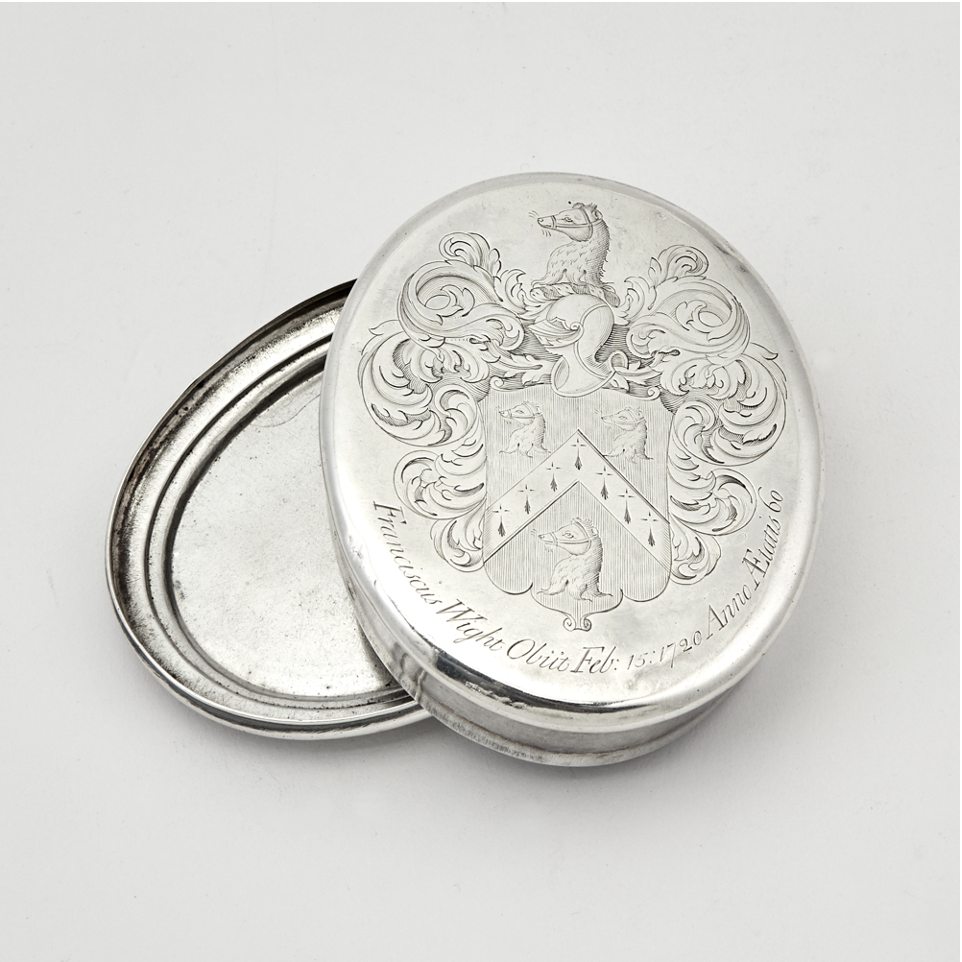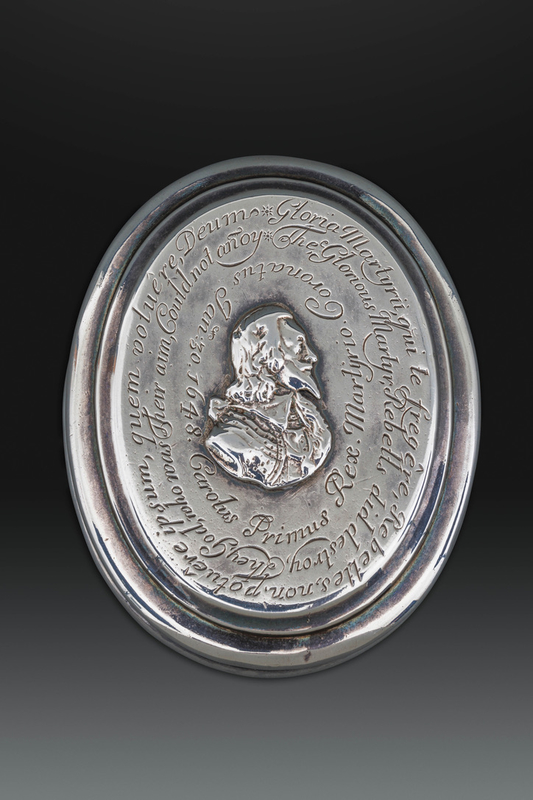Product Description
Provenance
Francis Wight (1660-1720) and by family descent
The Collection of Mr J. C. Lowry until sold at Christie’s on the 14th of December 1915 lot 34 (sold for 190s per Oz)
English Private Collection
Private Collection New York
Literature
The box was mentioned in Connoisseur March 1916 in the saleroom report column. “A Queen Anne oval tobacco-box, with moulded borders, the base engraved with a coat of arms and ” Franciscus Wight, Obit Feb: 15, 1720, Anno Aetatis 60″ ; to the lid applied a portrait bust in profile of Charles I., surrounded by inscription, ” Thee Glorious Martyr, Rebells did destroy. They, God, who was Their aim, could not annoy. Carolus Primus Rex. Martyrio. Coronatus Jan : 30, 1648,” by Edward Cornock, 1713, weight 4 oz., was knocked down for 190s. per oz. This interesting piece came from the collection of the late J. C. Lowry”.
For a discussion of the Briot medal which is the source for the portrait of King Charles I, see Pinkerton, J., ‘The Medallic History of England to the Revolution’, London, 1790 (fol.), xvi. 7.
The Iconography of the Box
This box was clearly designed as a tribute not just to King Charles I himself from a dedicated royalist but also as a statement of the owner’s belief in the divine right of kings. The inscription on the lid in Latin and English states that the aim of the parliamentary forces was the destruction of God in the person of the King, noting that they failed in their aims despite martyring the monarch.
The central portrait of Charles appears to have been adapted from a medal first issued in 1639-itself an adaptation of an earlier medal by the same artist. The artist Nicholas Briot had a fascinating career. Born in France in c.1579, he was appointed chief engraver at the Paris mint between 1606 and 1625 before moving to England in the same year. He was appointed chief engraver at the Royal Mint in 1633, later becoming Master of the Mint in Scotland between 1635 and 1639. He died in 1646 in Oxford.
An example of the Briot medal is in the collection of the British Museum, registration number M.7146, and is illustrated below.

Nicholas Briot’s medal issued in 1639
The Wight Family Arms
The base of this box is engraved with the arms of the Wight family, described in Burke’s General Armory as “Gu, a chev. erm. between three bears’ heads couped ar. muzzled sa.”. The inclusion of a memorial inscription to “Franciscus Wight” including his date of death (the 15th of February 1720) is also intriguing. Since the silvermsith Edward Cornock completed the box in 1713, and as this was certainly not likely to have been made for stock but rather as a bespoke commission, we are left to wonder whether Cornock’s workshop supplied the box in 1713 with the arms engraved but not the inscription which was then added to memorialise Wight after his death or whether the arms and inscription both date to 1720. Certainly the style and quality of the engraving is as one would expect to find on a piece from the Cornock workshops (see below) but of course there were many extremely talented engravers active in England in 1720 who would have been capable of producing work of this quality.

Edward Cornock
Apprenticed to Henry Grant, Cornock entered his first mark in 1708 and although a range of items bearing his mark survive, it is clear that he specialised in boxes-tobacco boxes being especially important to his business. Almost all of the surviving Cornock boxes encountered today are of relatively plain oval form with exceptional armorial engraving. The engravers employed by the Cornock workshop were clearly exceptionally talented and this is borne out by the quality of the heraldic work on the present example. The inset profile portrait of Charles I and the intricate engraving on the lid of the present piece sets this box apart from other known Cornock pieces such as the one in the Metropolitan Museum New York, donated by Judge Untermyer in 1968 which might be described as a more typical example of the maker’s output.
https://www.metmuseum.org/art/collection/search/205023
Cornock spent most of his career based in Carey Lane and died in 1734.
J.C. Lowry
Our research suggests that J. C. Lowry, of 93 High Holborn and who died in 1915, was a high-ranking member of staff at the P&O Ferry Company in London. Judging from the other pieces in his collection of silver, sold after his death at Christie’s on the 14th of December 1915, he was clearly a true silver enthusiast but presumably a man who bought his silver to be used rather than kept in a cabinet based on the other pieces that were sold at this time such as a large canteen of flatware, tea services etc. The tobacco box was chosen by Christie’s as one of the highlighted items in the sale and subsequently mentioned in a report in Connoisseur magazine as stated above and the quality of the piece stands as testament to Mr Lowry’s educated eye for silver.
Research and essay by Christopher Coles








Reviews
There are no reviews yet.